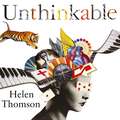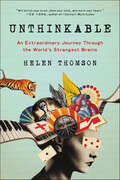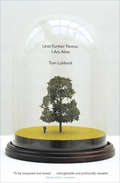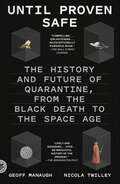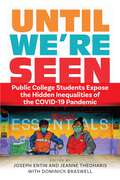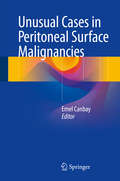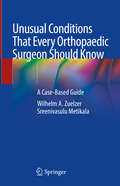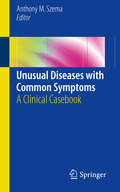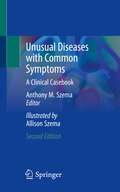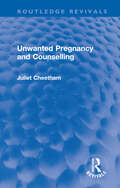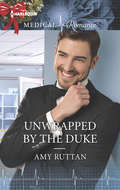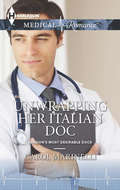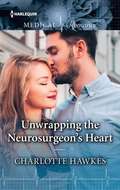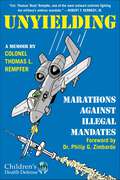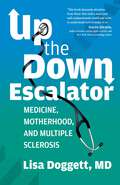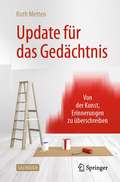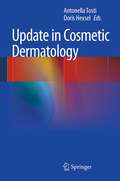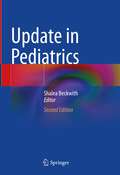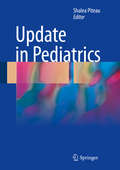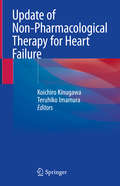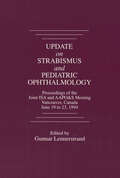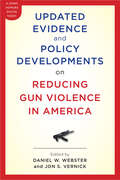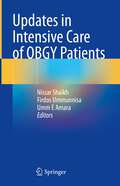- Table View
- List View
Unthinkable: An Extraordinary Journey Through the World's Strangest Brains
by Helen ThomsonHow the mind works -- everything from memory to emotion, navigation to creativity -- explained in nine extraordinary human stories.IMAGINE . . . getting lost in a one-room flat; seeing auras; never forgetting a moment; a permanent orchestra in your head; turning into a tiger; life as an out-of-body experience; feeling other people's pain; being convinced you are dead; becoming a different person overnight.Our brains are far stranger than we think. We take it for granted that we can remember, feel emotion, navigate, empathise and understand the world around us, but how would our lives change if these abilities were dramatically enhanced - or disappeared overnight? Award-winning science writer Helen Thomson has spent years travelling the world tracking down incredibly rare brain disorders. In Unthinkable she tells the stories of nine extraordinary people. From the man who thinks he's a tiger to the doctor who feels the pain of others just by looking at them, their experiences illustrate how the brain can shape our lives in unexpected and, in some cases, brilliant and alarming ways. Delving into the rich histories of these conditions, exploring the very latest research and cutting-edge medical techniques, Thomson explains the workings of our consciousness, our emotions, our creativity and even the mechanisms that allow us to understand our own existence. Story by remarkable story, Unthinkable takes us on an unforgettable journey through the human brain. Discover how to forge memories that never disappear, how to grow an alien limb and how to make better decisions. Learn how to hallucinate and how to make yourself happier in a split second. Find out how to avoid getting lost, how to see more of your reality, even how exactly you can confirm you are alive. Think the unthinkable.(P)2018 John Murray Press
Unthinkable: An Extraordinary Journey Through the World's Strangest Brains
by Helen ThomsonIn this Indiebound bestseller, the award-winning science writer unlocks the biggest mysteries of the human brain by examining nine extraordinary cases.Our brains are far stranger than we think. We take it for granted that we can remember, feel emotion, navigate, empathize and understand the world around us, but how would our lives change if these abilities were dramatically enhanced—or disappeared overnight?Helen Thomson has spent years travelling the world, tracking down incredibly rare brain disorders. In Unthinkable she tells the stories of nine extraordinary people she encountered along the way. From the man who thinks he’s a tiger to the doctor who feels the pain of others just by looking at them to a woman who hears music that’s not there, their experiences illustrate how the brain can shape our lives in unexpected and, in some cases, brilliant and alarming ways.Story by remarkable story, Unthinkable takes us on an unforgettable journey through the human brain. Discover how to forge memories that never disappear, how to grow an alien limb and how to make better decisions. Learn how to hallucinate and how to make yourself happier in a split second. Find out how to avoid getting lost, how to see more of your reality, even how exactly you can confirm you are alive. Think the unthinkable.“Helen Thomson’s remarkable book is an astonishing tour of the human brain in all its awesome power and bewildering variation . . . Unthinkable will enrich your brain, blow your mind, and warm your heart.” —Ed Yong, Pulitzer Prize-winning author
Until Further Notice, I Am Alive
by Tom Lubbock&“These are thoughts for us all, sooner or later—and this is a book I'll keep with me, as long as I live.&”—David Sexton, The Scotsman In 2008, art critic Tom Lubbock was diagnosed with a rare brain tumor and told he had only two years to live. Physically fit and healthy, and suffering from few symptoms, he faced his death with the same directness and courage that had marked the rest of his life. Lubbock was renowned for the clarity and unconventionality of his writing, and his characteristic fierce intelligence permeates this extraordinary chronicle. With unflinching honesty and curiosity, he repeatedly turns over the fact of his mortality, as he wrestles with the paradoxical question of how to live, knowing we&’re going to die. Defying the initial diagnosis, Tom survived for three years. He savored his remaining days; engaging with books, art, friends, his wife and their young son, while trying to stay focused on the fact of his impending death. There are medical details—he vividly describes the slow process of losing control over speech as the tumor gradually pressed down on the area of his brain responsible for language—but this is much more than a book about illness; rather, it's a book about a man who remains in thrall to life, as he inches closer to death. &“I hope that if I am ever diagnosed with a terminal illness I will remember to reread Until Further Notice, I Am Alive. It is, in its tough-minded way, truly joyous.&”—Lynn Barber, Sunday Times
Until Proven Safe: The History and Future of Quarantine, from the Black Death to the Space Age
by Geoff Manaugh Nicola TwilleyGeoff Manaugh and Nicola Twilley have been researching quarantine since long before the COVID-19 pandemic. With Until Proven Safe, they bring us a book as compelling as it is definitive, not only urgent reading for social-distanced times but also an up-to-the-minute investigation of the interplay of forces–––biological, political, technological––that shape our modern world.Quarantine is our most powerful response to uncertainty: it means waiting to see if something hidden inside us will be revealed. It is also one of our most dangerous, operating through an assumption of guilt. In quarantine, we are considered infectious until proven safe.Until Proven Safe tracks the history and future of quarantine around the globe, chasing the story of emergency isolation through time and space—from the crumbling lazarettos of the Mediterranean, built to contain the Black Death, to an experimental Ebola unit in London, and from the hallways of the CDC to closed-door simulations where pharmaceutical execs and epidemiologists prepare for the outbreak of a novel coronavirus.But the story of quarantine ranges far beyond the history of medical isolation. In Until Proven Safe, the authors tour a nuclear-waste isolation facility beneath the New Mexican desert, see plants stricken with a disease that threatens the world’s wheat supply, and meet NASA’s Planetary Protection Officer, tasked with saving Earth from extraterrestrial infections. They also introduce us to the corporate tech giants hoping to revolutionize quarantine through surveillance and algorithmic prediction.We live in a disorienting historical moment that can feel both unprecedented and inevitable; Until Proven Safe helps us make sense of our new reality through a thrillingly reported, thought-provoking exploration of the meaning of freedom, governance, and mutual responsibility.
Until We're Seen: Public College Students Expose the Hidden Inequalities of the COVID-19 Pandemic (Contemporary Ethnography)
by Joseph Entin and Jeanne Theoharis with Dominick BraswellFirsthand accounts of COVID-19’s devastating effects on working-class communities of colorThe first months of the COVID-19 pandemic were filled with talk of heroes, the frontline workers who kept the country functioning. “And when they write those history books, the heroes of the battle will be the hardworking families of New York,” Governor Andrew Cuomo trumpeted on Labor Day 2020. But what if those heroes, those essential workers and their families, wrote the book themselves?In Until We’re Seen, the heroes write their own stories. Through firsthand accounts by college students at Brooklyn College and California State University Los Angeles, Until We’re Seen chronicles COVID-19’s devastating, disproportionate effects on working-class communities of color, even as the United States has declared the pandemic over and looks away from its impacts.Very few of these students and their families had the luxury of laboring from home; if they were able to keep their jobs, they took subways and buses, and they worked. They drove delivery trucks, worked in private homes, cooked food in restaurants for people to pick up, worked as EMTs, and did construction. They couldn’t escape to second homes; if anything, more people moved in, as families were forced to consolidate to save money. Together, the accounts in this book show that the COVID-19 pandemic did discriminate, following the race and class fissures endemic to US society. But if these are tales of hardship, they are also love stories—of students’ families, biological and chosen—and of the deep resolve, mundane carework, and herculean efforts such love entails.Recounting 2020–2022 through the experiences of predominantly young, working-class immigrants and people of color living in the first two major US COVID-19 epicenters, Until We’re Seen spotlights previously untold stories of the pandemic in New York, Los Angeles, and the nation as a whole.
Untranslated Gene Regions and Other Non-coding Elements: Regulation of Eukaryotic Gene Expression
by Lucy W. Barrett Sue Fletcher Steve D. WiltonThere is now compelling evidence that the complexity of higher organisms correlates with the relative amount of non-coding RNA rather than the number of protein-coding genes. Previously dismissed as "junk DNA", it is the non-coding regions of the genome that are responsible for regulation, facilitating complex temporal and spatial gene expression through the combinatorial effect of numerous mechanisms and interactions working together to fine-tune gene expression. The major regions involved in regulation of a particular gene are the 5' and 3' untranslated regions and introns. In addition, pervasive transcription of complex genomes produces a variety of non-coding transcripts that interact with these regions and contribute to regulation. This book discusses recent insights into the regulatory roles of the untranslated gene regions and non-coding RNAs in the control of complex gene expression, as well as the implications of this in terms of organism complexity and evolution.
Unusual Cases in Peritoneal Surface Malignancies
by Emel CanbayThis book has been designed to provide the full description of the comprehensive management of peritoneal surface malignancies which have originated from different primaries, such as breast cancer, small bowel cancers and imatinib resistant GISTosis and sarcomas and pseudomyxoma. The book provides the most up-to-date information on current approaches such as cytoreductive surgery and hyperthermic intraperitoneal chemotherapy. Given the increasing evidence that the patients who may benefit from this treatment modality avoid potential lethal course of these diseases, the book explores the application of these approaches to a number of types of malignancy. The first chapters explore Benign Multicystic Mesothelioma and Pseudomyxoma Peritonei arising from unusual primaries. Among other explored topics are peritoneal metastases from serous papillary uterine carcinoma, sarcoma and from unusual origins. This book is valuable for surgical oncologists who deal with the management of peritoneal surface malignancies.
Unusual Conditions That Every Orthopaedic Surgeon Should Know: A Case-Based Guide
by Wilhelm A. Zuelzer Sreenivasulu MetikalaThis unique book presents unusual but critical medical conditions that may present to an orthopedic surgeon and that can - if undiagnosed, misdiagnosed or left untreated - result in serious risk to life and limb. Since these conditions are not necessarily common in orthopedic settings, the goal is to promote pattern recognition through the use of a consistent chapter format beginning with illustrative cases for each condition, followed by an appropriate review of the literature, relevant questions, recommended diagnostic and clinical approaches, and bulleted pearls and pitfalls. Conditions presented include necrotizing fasciitis, epidural hematoma, popliteal entrapment syndrome, allergies, coagulations issues, lead toxicity, and much more. Radiographs and intraoperative photographs enhance the case material.
Unusual Diseases with Common Symptoms: A Clinical Casebook
by Anthony M. SzemaThis book presents detailed case reports of unusual diseases with common symptoms, many of which have emerged in the past decade as a result of nature, advances in medical treatment, and increasing recognition of specific underpinnings of human biology and immunology. These rare diseases must now be considered when the mundane diagnoses do not exactly fit the patient's clinical history or treatment fails. Some of these diseases include: eosinophilic esophagitis, blastocystis hominis infection, and paromyces allergic fungal sinusitis. Chapters provide in depth clinical examples of a wide range of diseases affecting multiple organ systems. Each case is structured by: a vignette of the case, background / salient features of the case, diagnosis, treatment, key points, and questions to aid in critical thinking. Unusual Diseases with Common Symptoms: A Clinical Casebook is of great interest to practicing physicians and as a teaching resource for students and residents who will one day encounter conditions more complex than they initially appear.
Unusual Diseases with Common Symptoms: A Clinical Casebook
by Anthony M. SzemaThis book presents detailed case reports of unusual diseases with common symptoms, many of which have emerged in the past decade because of nature, advances in medical treatment, and increasing recognition of specific underpinnings of human biology and immunology. These rare diseases must now be considered when the usually considered diagnoses do not exactly fit the patient’s clinical history or treatment fails. The second edition of this text includes eighteen completely new chapters and cases. Some of the diseases discussed include galactose alpha 1,3 galactose IgE meat allergy, candymaker’s bronchiolitis obliterans from diacetyl, and Balsam of Peru contact allergic reaction from orange soda. Chapters provide in-depth clinical examples of a wide range of diseases affecting multiple organ systems. Each case is structured by a vignette of the case, background/salient features of the case, diagnosis, treatment, key points, and questions/answers to aid in critical thinking.Unusual Diseases with Common Symptoms: A Clinical Casebook (2nd Edition) follows the widely popular first edition, which has over 20,000 downloads worldwide. It is of great interest to practicing health care professionals as well as students and residents who will one day encounter conditions more complex than they initially appear.
Unwanted Pregnancy and Counselling (Routledge Revivals)
by Juliet CheethamThere was a growing concern in the 1970s about the number of unwanted pregnancies and the problems these posed for parents, children and society. Originally published in 1977, this was the first book which, with extensive reference to research material and illustrative case studies, provided a comprehensive analysis of the social and psychological background to unwanted pregnancy and a guide to ways of helping the people concerned. It should still be useful to doctors, nurses, midwives, teachers, social workers, and other professional and lay people whose work brings them into contact with those who are unhappy about a pregnancy. Juliet Cheetham, whose previous contributions to the problem areas of social welfare are widely respected, discusses the different meanings of unwanted pregnancy, and goes on to explore its relationship to the changing position of women; to the role of the contemporary family; to the special problems experienced by natural children and their parents; to existing social and medical provisions. She examines the possibilities, risks and limitations of the various responses to unwanted pregnancy and the services available at the time, and analyses the difficulties men and women experience in using contraception. Juliet Cheetham shows how the beliefs and attitudes of lay and professional people can influence their understanding of, and response to, these highly controversial and emotional subjects. She offers suggestions about the ways in which this influence may be appropriately modified, and the book concludes with a discussion of the special opportunities and problems of counselling those faced with an unwanted pregnancy.
Unwrapped by the Duke
by Amy RuttanAn unexpected inheritance... When Geri Collins learns she's the daughter of a lord her world changes in an instant. Running from a relationship gone wrong, she seizes the opportunity to help her gravely ill father by running his Harley Street clinic. If only she didn't have to deal with the sensual temptation of her new partner-the notorious "Dark Duke"! Thomas Ashwood unnerves her with every burning look and suggestive word. And as Christmas approaches Geri finds herself contemplating the consequences of a kiss under the mistletoe...
Unwrapping Her Italian Doc: Unwrapping Her Italian Doc / Tempted By The Bridesmaid / Italian Doctor, No Strings Attached / Even Film Stars Still Shop (London's Most Desirable Docs #704)
by Carol MarinelliThe ultimate Christmas present! Louise Carter is a midwife on a mission-to have the best Christmas ever! It's been a difficult year, but stealing a kiss under the mistletoe from gorgeous Italian obstetrician Anton Rossi will make sure it ends on a high! Anton is all about control-but around Louise he feels totally powerless! All he wants to do is kiss her smart mouth senseless-with chemistry this hot, who needs mistletoe anyway? And he certainly won't be stopping with just one kiss...
Unwrapping the Neurosurgeon's Heart: The Doctors' Christmas Reunion / Unwrapping The Neurosurgeon's Heart (Harlequin Lp Medical Ser.)
by Charlotte HawkesAt the heart of a playboy……is the man of her dreams.ER doc Anouk Hart wishes she could ignore her traitorous body’s reaction to high-flying neurosurgeon Solomon Gunn. Yet beneath his playboy reputation, Anouk sees flashes of compassion, which are even more dangerous than his charm! Especially when the warmth of Sol’s Christmas spirit starts to make her long to unleash the real Solomon Gunn and keep him by her side forever!“What an interesting, fast-paced, surprising and entertaining read Ms. Hawkes takes readers on with this book where…the dialogue was riveting and…the chemistry between this couple was strong and tangible from the moment they meet….”—Harlequin Junkie on Christmas with Her Bodyguard“Overall, Ms. Hawkes has delivered a really good read in this book where I smiled a lot because of the growing relationship between the hero and heroine…the romance was well worth the wait because of the building sexual tension between the pair….”—Harlequin Junkie on A Surgeon for the Single Mom
Unyielding: Marathons Against Illegal Mandates
by Thomas L. RempferUnyielding tackles a recurring topic of national importance as a history lesson for future generations. Controversial illegal medical mandates impacted military populations for many decades, but it was not until the COVID-era that the American people witnessed similar overreach. Colonel Tom &“Buzz&” Rempfer&’s memoir retraces the anthrax vaccine history since it marked the first time the military was served with court rulings condemning premeditated illegal experimentation on our nation&’s troops. The advent of COVID mandates, imposed on the population in 2021, gave the American people a taste of the mistreatment previously reserved for our nation&’s warriors. Legal protections enacted by the Congress to guard against medical experimentation, meant to ensure safe, effective, and FDA-approved products, were instead adulterated to foist mandates on American society. According to the FBI, the motive for the anthrax letter lab leaks in 2001 was to &“rejuvenate&” the &“failing&” anthrax vaccine. Similarly, the suspected Wuhan lab leak two decades later resulted in a push for COVID injections. The pattern of fear-based bioincidents resulting from reckless biodefense enterprises, and lessons not learned with illegal mandates, paralyzed government and military leaders while wreaking havoc on the trust and health of our troops and the American people. Buzz&’s decades-long analysis of the breakdowns stands as a unique treatise on the failures of leaders to learn lessons from these enduring clashes and to correct the damage. Future generations will sort out the aftermath, but in the meantime, Colonel Rempfer&’s Unyielding effort attempts to ensure that the lessons are not lost.
Up from Clinical Epidemiology & EBM
by O. S. MiettinenThe author of this book can be described as the father of modern epidemiology. Here he exposes the untenability of the prevailing teachings about clinical epidemiology and EBM, and advances a vision of major improvements in clinical medicine.
Up the Down Escalator: Medicine, Motherhood, and Multiple Sclerosis
by Lisa DoggettA memoir of triumph in the face of a terrifying diagnosis, Up the Down Escalator recounts Dr. Lisa Doggett&’s startling shift from doctor to patient, as she learns to live with multiple sclerosis while running a clinic for uninsured patients in central Austin. Recounting before and after the discovery of her MS, she chronicles vexing symptoms while trying to be an attentive mother, wife, and a caring family doctor.Facing the prospect of a career-ending disability as she adjusts to life with multiple sclerosis, Dr. Lisa Doggett is forced to deal with a new level of uncertainty and vulnerability, and the everyday fear that something new will go wrong. Taking off her white coat—becoming a patient herself—she confronts unimaginable fears, copes with her limitations, and sidesteps her skepticism of alternative medicine to seek help from unlikely sources. Drawing on riveting patient stories, Doggett reveals the dark realities of the dysfunctional U.S. healthcare system, made all the more stark when she becomes the one seeking care. MS pushes Doggett—a perfectionist at heart—to soften her inner drill sergeant and embrace self-compassion. As a patient, she learns to advocate for herself to ensure on-time medication deliveries and satisfactory treatment plans; to navigate chronic dizziness, relapses, and parenting frustrations; and to push her physical limits as a runner to go farther than ever before. As the director of a health clinic for the uninsured, Doggett&’s MS inspires an even deeper empathy as she confronts challenging cases, prompting her to work harder on behalf of those in her care, many of whom struggle with illnesses more serious than her own. This hopeful and uplifting book will encourage those living with chronic disease, and those supporting them, to power forward with courage and grace. It will spark conversations to redefine perfect parenting and trigger uncomfortable discussions and outrage about the vicious inequalities of health care in the U.S. Most of all, it will inspire readers to embrace the gifts of an imperfect life and look for silver linings, despite life&’s detours that sabotage plans and take them off their expected paths.
Update für das Gedächtnis: Von der Kunst, Erinnerungen zu überschreiben
by Ruth MettenDieses Sachbuch möchte Ihnen eine neue Sicht auf Ihr Gedächtnis eröffnen. Viele wird es wahrscheinlich überraschen: Das Gedächtnis ist keineswegs in Stein gemeißelt, sondern formbar. Erinnerungsspuren sind zu verändern – und zwar nicht nur, indem wir vergessen oder gar dement werden. Unter bestimmten Bedingungen lassen sich Gedächtnisinhalte tatsächlich überschreiben. Dafür sprechen inzwischen zahlreiche Forschungsergebnisse. Die Möglichkeit eines solchen Gedächtnis-Updates kann sogar therapeutisch genutzt werden – mit verblüffenden Effekten. Geschrieben für … alle, die mehr darüber wissen wollen, wie ihr Gedächtnis funktioniert. Über die Autorin: Dr. med. Ruth Metten arbeitet als niedergelassene Ärztin für Psychiatrie und Psychotherapeutin in ihrer Praxis schwerpunktmäßig mit Psychodrama, Hypnose und einer Kombination aus beidem – dem Hypnodrama – und hält zum Thema dieses Buches gut verständliche und nützliche Vorträge und Seminare.
Update in Cosmetic Dermatology
by Antonella Tosti Doris HexselThis well-illustrated guide provides concise descriptions of the most frequently encountered cosmetic skin conditions and essential information on commonly employed treatment procedures. The book opens with a description of skin evaluation systems and then documents etiology, pathogenesis, diagnosis, and treatment for various conditions, including cellulite, acne, hirsutism, and striae distensae. The second part of the book provides step-by-step guidelines on a range of cosmetic procedures, such as botulinum toxin injection, cryosurgery, electrosurgery, and injection lipolysis. The advice provided will be invaluable for all physicians who intend to incorporate these procedures into their practices. The book will also be of interest to established specialists in cosmetic dermatology wishing to update their knowledge and to all general dermatologists and plastic surgeons required to answer the numerous questions posed by patients seeking to maintain or improve the quality of their skin.
Update in Pediatrics
by Shalea BeckwithPediatrics is an evolving field of medicine and with many new advancements in knowledge, scientific research, and technology in recent years. This concise and comprehensive 2nd Edition of the textbook "Update in Pediatrics" provides an update and overview of the latest advances and current literature in Pediatrics, assisting health professionals to review cutting-edge information in the different subspecialties in Pediatrics. This book is structured into chapters based on the various subspecialties in Pediatrics, and includes chapters ranging from traditional disciplines such as Infectious Disease and Cardiology, to more current disciplines such as Adolescent Medicine and Child Maltreatment. The team of authors is made up of experienced and expert clinicians and researchers in their respective fields. The target audience for this book includes any practitioner who cares for children, including pediatricians, family doctors, nurses and nurse practitioners, allied health professionals, residents, medical students, and health researchers providing an indispensable resource for the busy clinician and learner who wishes to stay up-to-date with the latest advances and knowledge in the field.
Update in Pediatrics
by Shalea PiteauThis concise and comprehensive volume updates health professionals on recent advances in the field of pediatrics. It includes chapters in every subspecialty of pediatrics, such as critical care, development emergency medicine and genetics. Ranging from traditional disciplines such as infectious disease and cardiology to more current disciplines such as adolescent medicine, metabolics and genetics this is an indispensable guide for the busy clinician who wishes to stay up-to date with latest advances in the field.Through the use of summaries and bullet points, the book conciselly describes the latest recommendations and guidelines in pediatrics and provides a good overview of the available technology for each subspecialty.The team of authors is made up of experienced clinicians and researchers in their respective fields. This book appeals to pediatricians, family doctors, nurses and nurse practitioners, allied health professionals, and health researchers.
Update of Non-Pharmacological Therapy for Heart Failure
by Koichiro Kinugawa Teruhiko ImamuraThis book offers essential guidance on the diagnosis, management and treatment of heart failure using the latest Ventricular Assist Devices and approaches such as Cardiac Resynchronization Therapy, Implantable Cardioverter Defibrillator, Non-invasive Positive Pressure Ventilation, Intra-Aortic Balloon Pumping, Extra Corporeal Membrane Oxygenation and so on. It provides practical guidelines on the monitoring using those devices, as well as techniques and treatment strategies, and features two dedicated chapters on heart transplants and regenerative therapy. The main content is complemented by a wealth of full-color figures and diagrams to clearly demonstrate the operative techniques and tools discussed. Given its scope, Update on Non-pharmacological Therapy for Heart Failure offers a valuable resource, not only for cardiologists and cardiac surgeons, but also for clinical residents and medical students.
Update on Strabismus and Pediatric Ophthalmology Proceedings of the June, 1994 Joint ISA and AAPO&S Meeting, Vancouver, Canada
by Gunnar Lennerstrand Shinobu AwayaThis book provides useful information on new observations and therapeutic approaches to common problems encountered in strabismus and pediatric ophthalmology. It also discusses the ocular findings in a number of rare conditions.All aspects of pediatric ophthalmology are addressed. The book describes a new strabismic condition and provides updates on research in the development of normal and abnormal monocular and binocular vision, and in ocular motility. All different strabismus types and their characterizations are covered, as well as nystagmus and other ocular motor disorders. The latest advances in relevant surgical and pharmacological management are discussed. Recent research on diseases of the lacrimal system, the anterior segment, cataracts, posterior segment, and neuro-ophthalmology is extensively covered.Update on Strabismus and Pediatric Ophthalmology presents the proceedings of the joint meeting of the VIIth Congress of the International Strabismological Association (ISA) and the 20th Annual Meeting of the American Association for Pediatric Ophthalmology and Strabismus (AAPO&S). The meeting had more than 750 participants, making it the largest conference ever held in the field of strabismus and pediatric ophthalmology.
Updated Evidence and Policy Developments on Reducing Gun Violence in America
by Daniel W. Webster Jon S. VernickThis digital update to Reducing Gun Violence in America presents new evidence and developments in the effort to address the staggering toll of gun violence in the United States.In 2013—in the wake of the tragic shooting at Sandy Hook Elementary School—Johns Hopkins University Press published Reducing Gun Violence in America, a collection of essays written by the world’s leading experts on gun violence. Updated Evidence and Policy Developments on Reducing Gun Violence in America follows up on the state of American gun violence by analyzing new data, research, and policy developments one year after Sandy Hook. Over the course of ten substantive chapter addendums, contributors bring readers up-to-date on such varied topics as mental illness, domestic violence, background checks, illegal gun sales, and personalized guns. They describe the recent policy measures that have been enacted and suggest additional approaches that may help stem the violence. An essential companion to Reducing Gun Violence in America, the reliable, empirical research and legal analysis in this e-book will help lawmakers, opinion leaders, and concerned citizens identify policy changes to address gun violence, which takes an average of more than 80 lives every day in the United States.
Updates in Intensive Care of OBGY Patients
by Nissar Shaikh Firdos Ummunnisa Umm E AmaraThis book presents the updated management of acute and critically ill obstetric and gynecological patients. It describes patients' care with pregnancy-induced medical disorders, comorbidities, and gynecological (OBGY) conditions requiring acute and intensive care support therapy. This book will guide early diagnosis and speedy management of life-threatening conditions. Chapters provide a comprehensive and systemic approach in an easy-to-understand format. Along with diseases and comorbidities of pregnancy, acute illness and its management caused by in vitro fertilization (IVF) are focused on, and a dedicated chapter about COVID-19 infection in obstetric patients is provided.Updates in Intensive Care of OBGY Patients will support intensivists, obstetricians, gynecologists, acute care physicians, and surgeons. Residents, fellows, specialists, and other junior medical staff working in intensive care units will also value this source. It will also help to broaden the understanding of nurses and paramedical staff in intensive care therapy.
